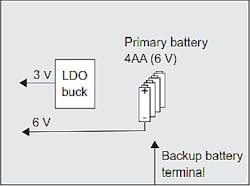Portables, IoT Fuel Demand for Low-Iq Power Converters
This article is in TechXchange: Why Low Iq is the Smart Thing to Do
Members can download this article in PDF format.
What you'll learn:
- Low Iq in LDO design and the impact on power loss.
- A look at the bidirectional buck/boost converter.
- Optimizing power in Wi-Fi and other comm devices.
Today’s electronic devices, especially worn on the body, are small, lightweight, and mostly powered by batteries and regulated by low-quiescent-current (Iq) power converters. Such devices as cardiac monitoring patches, continuous glucose monitors (CGMs), insulin therapy patch pumps, and various biosensors rely on very low Iq, which will greatly extend the life of the batteries.
Some really incredible medical devices that feature low-Iq designs include:
- 3M Prevena Plus Duo Incision Management System with 3M Prevena Peel and Place Dressing
- Wireless, medical wearable ECG, SpO2, PTT, and heart-rate monitors are operated using a single CR3032 battery and provide a battery life of 30 days
Power designers that need very low Iq must craft a delicate balance between low quiescent current and high performance in portable/body-worn, battery-operated designs. The judicious balance between standby and sleep modes is a major aspect that must be carefully considered in these kinds of design challenges. Battery life in such systems can be extended from two years to greater than five years with an optimum design architecture for each particular application.
Low-Dropout Regulators
Designers of low-dropout regulators (LDOs) are creatively reducing Iq year after year: The Iq in 5-V LDOs has reduced approximately 90% every three years over the past 10 years.
Iq refers to the current drawn by the LDO in an enabled and no-load condition. In LDOs, the main contributors of Iq are the voltage reference and error amplifier. Designers must select devices that will help minimize the amount of total Iq consumed by the overall system to extend battery life.
Devices like smart water meters, smoke detectors, smart watches, thermostats, and health monitors typically spend most of their time in low-power modes. The typically have battery backup devices as well (see figure).
A great example of an application for low quiescent current is building automation. Devices in smart buildings will sense the surrounding environment with the Internet of Things (IoT) and intelligently control heating, cooling, lighting, as well as water. Low-Iq designs enable the IoT to work more efficiently and reduce carbon emissions for a healthier environment.
How Much Will the Iq Contribute to System Power Loss?
Designers need to select LDOs that will minimize the total Iq consumed by the system to extend battery life. The overall power consumption of the system (PD), in relation to Iq, demonstrates how much the Iq contributes to power loss:
(VIN – VOUT) x IOUT + (VIN x IGND) = PD
In this example, an LDO regulator is used to regulate power for a 1.8-V wireless microcontroller, powered by a 3-V CR2032 coin-cell battery with a capacity of 235 mAh. If the microcontroller is in the active mode, needing an output current (IOUT) of 100 µA, and the LDO has 1.3 µA of IGND at the load, the PD is now 123.9 µW.
When the system switches to a low-power mode, the Iq will represent 56% of the total dissipated power—IOUT becomes a much lower 2 µA, IGND drops to 1 µA at that load, the PD is now a very low 5.4 µW.
Bidirectional Buck/Boost Converter with Low Iq
A good bidirectional buck/boost power converter can use its buck mode to charge such things as supercapacitors while maintaining a low Iq of 60 nA, which will help extend battery life by 20%, as opposed to using hybrid-layer capacitors (HLCs) for peak load support. This type of design can help applications run on a single battery for 10 or more years.
In boost mode, such a power converter is perfect for battery-powered wearables as well as certain portable devices.
Minimizing Quiescent Current in Low-Power Designs
Designers will need to quantify the Iq and power losses over the entire output load range, prior to assessing the tradeoffs in performance specifications. For dc-dc switching converters, examine the power efficiency over load current; for LDOs, check efficiency over the entire load current range to be used.
In Wi-Fi and other communications devices,3 designers must optimize power savings during standby. They may begin by lowering the amount of power consumed during the power floor (this is the state where all components are inactive/idle and power is dominated by the static leakage of the hardware). Once this is done, the power consumed via Wi-Fi and other communications devices can be addressed. Designers need to be sure that Wi-Fi and communications devices don’t unnecessarily wake the system-on-chip (SoC), which will further cause more activity in the operating system and applications.
Summary
Electronic devices that can be typically powered via batteries are LDO linear voltage regulators and dc-dc converters. These are usually in the “ON” mode. In the last 10 years, all of the above power devices have lowered their power consumption. Many such devices have been updated to work in normal mode, sleep mode, standby mode, power-saving mode, hibernation mode, and shutdown mode.
Today, remote sensor nodes, wearables, medical devices, and other IoT components can give designers more flexibility in their power architectures. The bottom line here is to reduce quiescent current (Iq) in any creative ways possible.
In this article, we have only scratched the surface of some ideas. Designers are encouraged to pursue extensive research on the latest methods of minimizing Iq and using creativity in the power designs of their systems.
Read more articles in TechXchange: Why Low Iq is the Smart Thing to Do
References
1. The Importance of Low IQ in Power-Supply Design | Electronic Design.
2. Wireless ECG, SpO2, PTT and heart rate monitor reference design for medical and consumer wearables, TIDA-01580.

